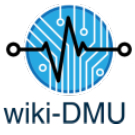PS:Filière post urgences : Différence entre versions
De wikiDMU
| Ligne 1 : | Ligne 1 : | ||
| − | <p style="text-align: center"><span style="font-size:larger">'''[[File:Coeur ecg.png|right|250px|link=]]Filière post urgences insuffisance cardiaque aigûe'''</span> </p> | + | <p style="text-align: center"><span style="font-size:larger">'''[[File:Coeur ecg.png|right|250px|Coeur ecg.png|link=]]Filière post urgences: insuffisance cardiaque aigûe'''</span> </p> |
== '''Population concernée''': == | == '''Population concernée''': == | ||
| Ligne 22 : | Ligne 22 : | ||
---- | ---- | ||
| + | | ||
== '''plus d'info:''' == | == '''plus d'info:''' == | ||
Version du 3 juillet 2020 à 06:42

Filière post urgences: insuffisance cardiaque aigûe
Sommaire
Population concernée:
Insuffisance cardiaque aiguë après avoir écarté un SCA.
Traitement :
VNI et/ou CiPAP et dérivé nitré et/ou diurétiques
Calcul du score MEESSI :
- Pour Barthel et Troponine : cocher « Unknown » Score de MESSI
- Risque haut : Hospitalisation encouragée, en cardiologie.
- Risque bas : Traitement ambulatoire, fonction du contexte.
- Risque intermédiaire : Orientation selon jugement du médecin.
- Préciser dans la conclusion le niveau de risque selon MEESSI.
Pour chaque patient concerné : Faire une demande de consultation en externe en précisant : « Filière ICA », y compris pour les patients hospitalisés
Mise à jour: 3 juillet 2020
plus d'info:
MEESSI-AHF is a risk model to predict 30-day mortality in patients attending Emergency Departments (ED) with a diagnosis of Acute Heart Failures (AHF).
The MEESSI-AHF score was derived on 4867 consecutive AHF patients admitted to Spanish ED during 2009-2011, and then validated in 3229 consecutive AHF patients during 2014. (Note patients also with ST elevation myocardial infarction are excluded)
The MEESSI-AHF risk model includes 13 variables readily available on arrival to Emergency Department. The 40% of patients classified as LOW RISK (30-day mortality: <2%) should be considered as potential candidates to be early discharged from Emergency Department without admission after adequate response to initial treatment. The 10% of patients classified as VERY HIGH RISK (30-day mortality: >2%) may clearly benefit from hospital admission.
For some patients troponin, NT-proBNP and/or Barthel index values may be unknown. In such cases we still enable the risk score to be derived.
